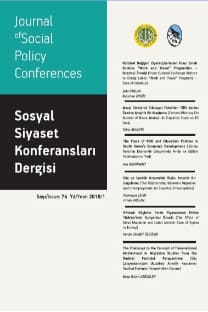Temel Dinamikleriyle Çin İşçi Hareketleri: 2008 Krizi Sonrası Dönemin Çok Yönlü Kuramsal Analizi
Kriz sonrası dönemde Çin ekonomisi; artmaya devam eden nüfus, istihdam ve GSYİH, daralan tarım ve sanayi sektörü, genişleyen hizmet sektörü, kademeli azalan büyüme oranları, önemli oranda değişmeyen işsizlik ve işgücüne katılım oranları çerçevesinde şekillenmiştir. Bu kapsamda çalışmanın temel amacını kriz sonrası dönemde artan bir ivme kazanan işçi hareketlerinin belirlenen siyasi, ekonomik, teknolojik, sosyal ve STÖ dinamikleri çerçevesinde analiz etmek oluşturmaktır. Analiz sürecinde Çin İşçi Bülteni (ÇİB) verileri dikkate alınmıştır. Veriler ÇİB internet sitesinden derlenmiş olup muğlak konularda çevrimiçi yazışmalara başvurulmuştur. Sonuç olarak korporatizm ilişkileri sisteminde Parti-Devlet sisteminin nüfuzunu devam ettirmesi, liberal politikalara ağırlık verilmesi, hem üretimde hem de kullanımda robotlaşmanın hızlanması, kırdan kente devam eden işçi göçü ve bu göçün bazı sektörlerde daha fazla yoğunlaşması daha çok bağımsız hareket eden STÖ’lerin işçi hareketlerine öncülük etmesi bu sürecin temel dinamiklerini oluşturmaktadır. İşçi hareketlerinin temel nedenini ise ücret alacakları konusu oluşturmaktadır. Hareketler en fazla inşaat ve imalat sektörlerinde yoğunlaşmıştır. Hareketlerin önemli bir kısmı özel girişimlerde görülürken bunu KİT’ler ya da mülkiyeti bulunamayan şirketler takip etmektedir. Hareketlerin büyük bir kısmı protesto niteliğinde değerlendirilirken bunu oturma eylemleri ve grevler takip etmiştir. Hareketlerin büyük çoğunluğu 1-100kişiden oluşmuştur. Yapılan eylemlere yanıt ise polis müdahalesi başta olmak üzere devlet müdahalesi ve yönetim müzakereleri şeklinde gerçekleşmiştir.
Anahtar Kelimeler:
Çin, İşçi Hareketleri, Protesto-Grev, Endüstri İlişkileri, Sendika
Chinese Labors’ Movements with their Basic Dynamics: Multiple Theoretical Analysis of the Post-2008 Period
The Chinese labor market in the post-crisis period; has been shaped by growing employment and GDP, shrinking agriculture and industrial sector, expanding service sector, gradually decreasing growth rates, unchanged unemployment and labor force participation rates. In this context, the main purpose of the study is to analyze the labor movements that gained momentum in the post-crisis period within the framework of determining political, economic, technological, social and GO dynamics. In the analysis process, data from the Chinese Labour Bulletin (CLB) were taken into consideration. The data were compiled from the CLB website and online correspondence was used on ambiguous issues. As a result, the basic dynamics of this process in the post-crisis industrial relations system are as follows: Party-State system to continue its influence, focusing liberal policies, acceleration of robotization both in production and use, continuing labor migration from the rural to the city and the more concentration of this migration in some sectors, the more independently acting NGOs lead the labor movement. The main reason for the workers’ movements is the issue of wage arrears. Movements are most concentrated in the construction and manufacturing sectors. While a significant part of the movements is seen in private enterprises, this is followed by SEEs or companies without ownership. Most of the movements were considered as protests, followed by sit-ins and strikes. The majority of the movements consisted of 1-100 people. The response to the movements realized, primarily police intervention, state intervention management negotiations.
Keywords:
China, Labors’ Movements, Protest and Strike, Industrial Relations, Trade Union,
___
- Chan, J. (2019). State and labor in China 1978-2018. https://onlinelibrary.wiley.com/doi/full/10.1111/wusa.12408.
- CLB. (2010). Latest Report on the Foxconn Suicides. https://clb.org.hk/content/latest-news-reports-foxconn-suicides.
- CLB. (2016). Strikes and Protests by China's Worker's Soar to Record Heights in 2015. https://clb.org.hk/en/content/strikes-and-protests-china%E2%80%99s-workers-soar-record-heights-2015.
- CLB. (2018). China's Truck Drivers on Strike Again in Protest at Government Emission Policy. https://clb.org.hk/content/china%E2%80%99s-truck-drivers-strike-again-protest-government-emissions-policy.
- CLB. (2019). Migrant Workers and Their Children . https://clb.org.hk/content/migrant-workers-and-their-children.
- CLB. (2020). Workers' Rights and Labour Relations in China. https://clb.org.hk/content/workers%E2%80%99-rights-and-labour-relations-china.
- Giuntella, O., & Wang, T. (2019). Is an Army of Robots Marching on Chinese jobs. IZA Institute of Labor Economics, Discussion Paper Series. https://www.iza.org/publications/dp/12281/is-an-army-of-robots-marching-on-chinese-jobs .
- Griffins, J. (2016). China on Strike. https://edition.cnn.com/2016/03/28/asia/china-strike-worker-protest-trade-union/index.html.
- Huang, Z. (2015). China Has Seen a 13-fold Increase in Labor Strikes and Protests Since 2011 and It's Cracking Down . https://qz.com/580553/china-is-cracking-down-on-labor-rights-ngos-in-its-worlds-factory-with-a-state-media-smear-campaign/.
- IFR. (2019). World Robotics 2019 Preview. https://ifr.org/news/summary-outlook-on-world-robotics-report-2019-by-ifr/.
- ILO. (2016). Wages Productivity and Labour Share in China. https://www.ilo.org/asia/publications/WCMS_475254/lang--en/index.htm .
- ILO. (2020). Labor Migration in China and Mongolia. https://www.ilo.org/beijing/areas-of-work/labour-migration/lang--en/index.htm.
- King, C., & Chan, C. (2018). Changes and Continuity: Four Decades of Industrial Relations in China. https://socialistproject.ca/2018/08/changes-and-continuity-four-decades-of-industrial-relations-in-china/.
- Kumar, A. (2014). 5 Reasons the Strike in China is Terrifying (to Transnational Capitalism). https://novaramedia.com/2014/04/25/5-reasons-the-strike-in-china-is-terrifying-to-transnational-capitalism/.
- Lee, C. H., & Liu, M. (2012). Geçiş Sürecindeki Toplu Pazarlık: Çin’de Kolektif Sesin Etkilerini Ölçmek. Ed: S. Hayter, Küresel Ekonomide Toplu Pazarlığın Rolü (ss. 212-235). Ankara: Efil Yayınevi.
- Lin, I.-T. S. (2018). The Robotics Industry in China. https://www.china-briefing.com/news/chinas-robot-industry/.
- Ma, Z. (2011). Industrial Relations in China: A Review Based on a Six-Party Model . file:///C:/Users/hp/Downloads/IR%20China.pdf.
- Ngai, P., & Chen, J. (2012). Global Capital, The State and Chinese Workers: The Foxconn Experience. Modern China, 4(38), 383-410.
- ODI. (2019). Global China 2049 Initiative. https://www.odi.org/projects/china-2049-initiative?gclid=EAIaIQobChMIkYWFlun-6wIVRNiyCh0RPQE9EAAYASAAEgI7ofD_BwE.
- Rhodes, E. (2019). How Robotics Changed the Business Landscape in China. https://asiatimes.com/2019/08/how-robotics-changed-the-business-landscape-in-china/.
- Statista. (2019). Avarage Annuals Wages in China from 2008 to 2018. https://www.statista.com/statistics/743522/china-average-yearly-wages/ .
- Traub-Merz, R. (2011). The All China Federation of Trade Unions (ACFTU): Structure, Functions and the Challenges from Collective Bargaining. R. Traub-Merz, & K. Ngok içinde, Industrial Democracy in China (s. 11-51). Shanghai/Guangzhou: China Social Sciences Press.
- ISSN: 1304-0103
- Yayın Aralığı: Yılda 2 Sayı
- Başlangıç: 1948
- Yayıncı: İstanbul Üniversitesi Yayınevi
Sayıdaki Diğer Makaleler
Kültür Endüstrisinden Dijital Kapitalizme
İnsana Yakışır İş Açığı: Çalışan Yoksulluğu Açısından Bir Değerlendirme
Sosyal Güvenliğin İşgücüne Katılma Oranına Etkisi
Giden Arama Yapan Müşteri Temsilcilerinin Sorunlarının Belirlenmesine Yönelik Nitel Bir Araştırma
Changes in Poverty-fighting Tools: From “Traditional” to “New Tendencies”
